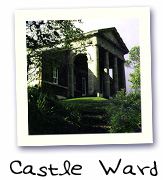 |
Search the site:

Castle Ward, County DownWhen Mary Delany visited Castle Ward in 1762 she was so moved she remarked: 'altogether one of the finest places I ever saw'. Many modern visitors will share this opinion, for the 800-acre landscape park at Castle Ward, overlooking an inlet of Strangford Lough, remains a place of idyllic and serene beauty. For the garden historian, it is also a place of considerable interest as the park has residual remains of a history of garden development spanning four centuries.
Visitors to the grounds should park their car in the farmyard close to the tower house built by the Ward family in the late sixteenth century. From here there is a path into the park where a short distance north west, on a slight ascent, stands the site of a grand house built by the Wards around 1710. This was demolished in the mid nineteenth century, but much survives of its surrounding formal gardens laid out in the 1720s. These include splendid yew terraces forming two tunnels sixty-metres long, the site of a canal between two recently replanted double rows of limes, and a 530 metre long canal known as the Temple Water - the largest ornamental garden feature to survive in Ireland from the early eighteenth century. The scale and grandeur of this feature is particularly impressive when viewed from the south-west end where it is aligned upon the much earlier Audley's Castle. The adjacent early nineteenth-century Walled Garden now houses a wildfowl In the mid nineteenth century the park was enlarged and a major reorganisation of the gardens took place around the house. On the site of the old Georgian flower garden the Wards built the terraced Windsor Garden. lts sunken area, which once held an elaborate parterre, now has a small circular pond with a statue of Neptune, but the bedding arrangement on the terraces largely retains its Victorian layout while the symmetric ally placed cordylines and the screen of Irish yews on the west side perpetuate the formal planting design. The adjacent Pinetum, also established around 1840 contains a collection of spruces, pines, firs and other trees introduced from America and the Pacific in Victorian times. A large rockery built against the wall of the old garden is an Edwardian addition to the garden. Located 1 mile west of Strangford on the Downpatrick Road. NGR: J 573494. Open daily from dawn to dusk. Castle Ward house open from April to October (days and times may vary). Restaurant and gift shop in stable-yard open as house. Toilet facilities. Mostly suitable for wheel chairs. Dogs on lead. Admission charge (entrance to house extra). From the Appletree Press title: Irish Gardens. |
All Material © 1999-2005 Irelandseye.com and contributors

 collection, while on the slopes above the charming Lady Anne's Temple, built around 1750, commands the scene. From here the visitor will view the Temple Water as well as the surrounding informal landscape park - laid out between 1758 and 1767 as a setting for the present house some distance to the south.
collection, while on the slopes above the charming Lady Anne's Temple, built around 1750, commands the scene. From here the visitor will view the Temple Water as well as the surrounding informal landscape park - laid out between 1758 and 1767 as a setting for the present house some distance to the south.